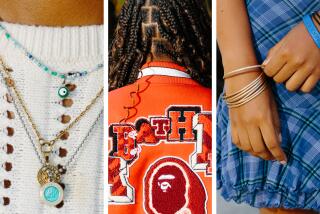In Gore Campaign War Room, All Eyes Are on His Wardrobe
- Share via
WASHINGTON — While inside-the-Beltway boys declared Al Gore’s spiffy new wardrobe evidence that “Al the Stiff” is casting about for a more salable image, fashion and media mavens viewed his new duds as, well, clothes.
From Democratic media man Michael Sheehan to fashion historian Anne Hollander and GQ magazine editor Art Cooper, the consensus is that politicians have long used clothing to send subtle messages to voters without imperiling their political futures or raising the question of their authenticity.
But that said, the politicians must do it right.
Sheehan says a candidate’s biggest mistake is to make a point of his clothes, as did Republican presidential hopefuls Lamar Alexander and Bob Dole in 1996.
Almost all the experts invoked Alexander as the classic “fashion don’t,” so to speak, for wearing his fabled red plaid shirts and then talking about them as evidence that he was just like regular folks. Dole, too, was considered to have blundered after he quit the U.S. Senate wearing a dark suit and showed up the next morning tieless and in a powder-blue sport jacket to campaign in Chicago. He was liberated in every way from Capitol politics, he said. A new man, overnight.
Gore went on the road this fall looking newly fashionable and perhaps a bit intimidating to the political establishment, which likes its elected officials in nondescript blue suits, white shirts and boring ties.
The bad spin stained Gore’s campaign with the notion he was somehow not comfortable in his own skin and, thus, was trying to redress the issue with new clothes: tawny-toned three-button suits and blue shirts that women (voters) in particular might find appealing. The volume of clucking ratcheted up when Time magazine reported that the VP was paying feminist author Naomi Wolf $15,000 a month for, among other things, sartorial tips. Sheehan, who has advised both Gore and his Democratic competitor, Bill Bradley, defended the vice president for fine-tuning his wardrobe, if not his overall image.
“Sometimes you’ve got to look for the simplest scenario for an explanation: Maybe we don’t want to look like a sitting vice president but like an activist campaigner--so we wear something different on the road.”
Gore’s updated threads invigorated interest in the other guys’ clothes, and campaign aides, being who they are, used the questioning as yet another opportunity to spin.
Seems that Bradley and Republicans George W. Bush, John McCain and Steve Forbes have more in common than they might think: They’re all “tight-fisted,” “no frills” guys, men of real “substance,” without vanity or a care about something as silly as clothes. And if they ever veer from the uniform, it’s to wear some “goofy” tie, usually given to them by one of their kids.
Bush is sort of “Everyman fashionable,” says his media advisor, Mark McKinnon. “I don’t think he spends a lot of time thinking about it. He spends more time thinking about policy.”
McCain and Bradley are off-the-rack shoppers who both “needed” new shoes and bought them at campaign stops in New Hampshire. And then there’s the wealthy Forbes, the last of the “bargain shoppers,” says an aide.
Although Cooper is a little suspicious of the new Mr. Gore, the GQ editor likes the look and sees no danger in a presidential candidate getting out front of the voters in fashion. (Gore certainly isn’t in danger of that: the three-button suit has been hot for so long now it’s almost out.)
Hollander, who wrote “Sex and Suits,” says politicians are supposed to wear suits and, yes, the clothes tell us something about the man.
“This is a 700-year-old fact in modern civilization about our life: that what we choose to wear is part of our general vision of ourselves. Of course, persons in public life have to think hard about this and they never have not. The problem now is that folks like you and me are having conversations about this.”
She thinks the buffed-up Gore’s best strategy is to “smile mysteriously, and when someone remarks on his clothes to simply say, ‘Who me?’ ”
*
Times staff writer Maria L. La Ganga contributed to this story.
More to Read
Get the L.A. Times Politics newsletter
Deeply reported insights into legislation, politics and policy from Sacramento, Washington and beyond. In your inbox twice per week.
You may occasionally receive promotional content from the Los Angeles Times.









